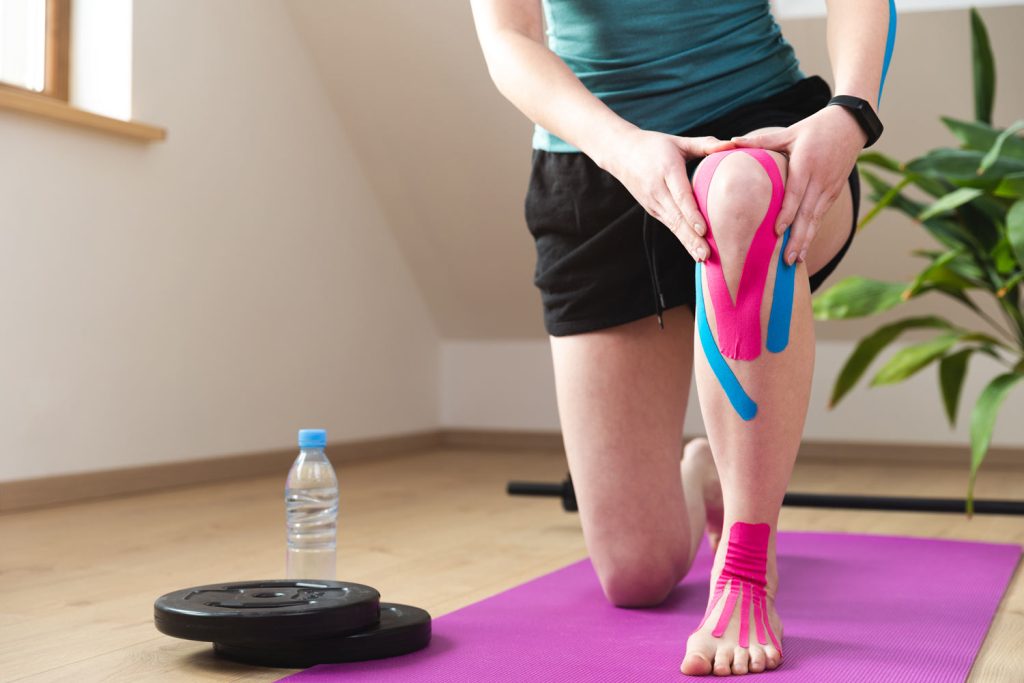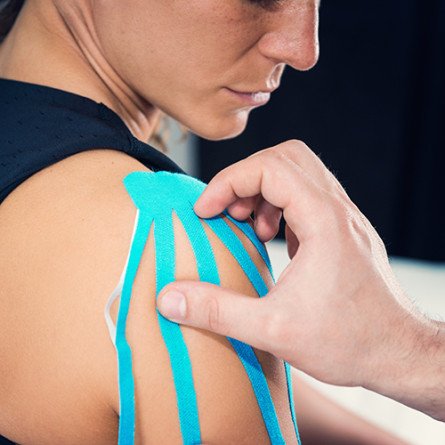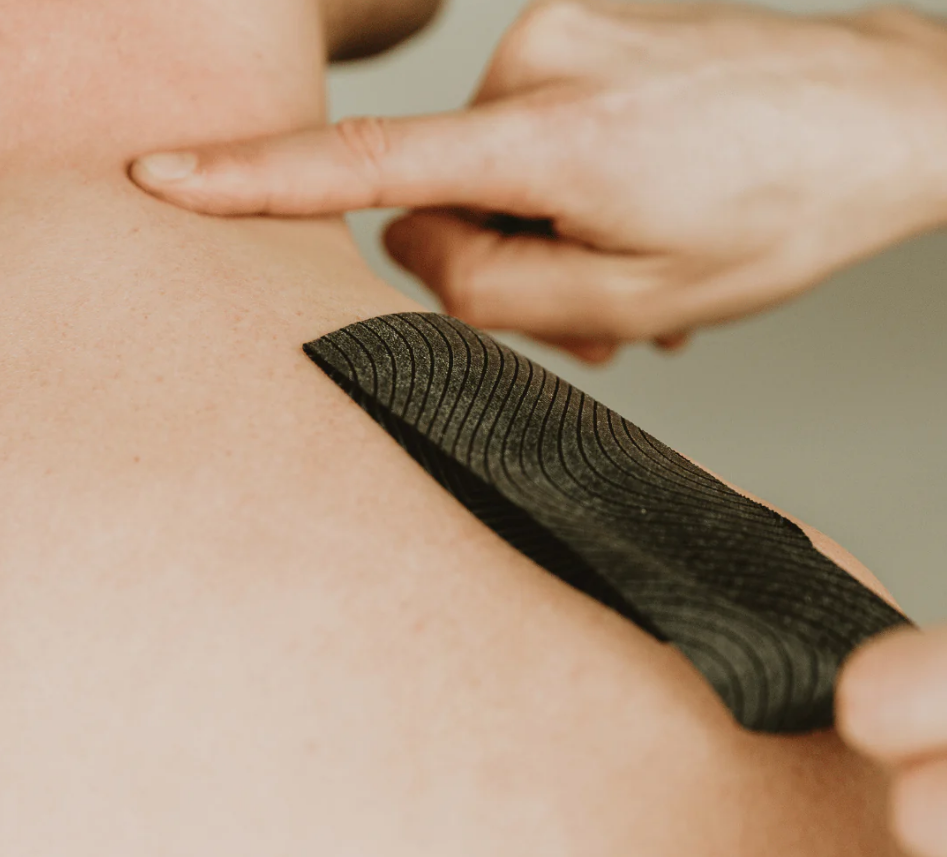Basic Techniques for Applying Kinesiology Tape
Kinesiology tape is crafted from a cotton and synthetic fiber blend, allowing it to stretch 40-60% of its resting length, which mimics the natural elasticity of human skin. This stretchability is key to the tape’s ability to provide dynamic support without restricting movement.
Essential Steps for Application
Skin Preparation: The effectiveness of kinesiology tape relies heavily on its ability to adhere to the skin. Begin by cleaning the area with soap and water to remove any oils, lotions, or dirt. If you have sensitive skin, consider applying a thin layer of pre-tape spray or liquid to protect the skin.
Cutting and Application: Measure the length of tape needed for the specific body part. Cut the tape and round the corners to prevent the edges from catching on clothing and peeling off. Peel the backing off the first inch of tape, and apply it to the designated starting point without stretching it—this is your anchor point.
Stretch and Apply: Remove the backing from the rest of the tape as you gently stretch it (typically between 25% and 75% of its maximum stretch capacity, depending on the desired effect and body part). Lay the tape over the skin in the pattern or shape that best suits the therapeutic needs of the area. For instance, kinesiology tape for shoulder pain might require an application style that differs from that used for kinesiology tape on the knee or kinesiology tape for ankle pain.

Some pre-wrapped kinesiology tapes are designed for specific locations.
Rub to Activate Adhesive: Once applied, rub the tape briskly from the center outward. The heat generated from this friction activates the pressure-sensitive adhesive, which ensures the tape stays put for several days, through showers, swims, and sweaty workouts.
Post-Application: After applying the tape, it’s normal to see some wrinkling or bunching of the tape as you move. This is part of the tape’s mechanism to lift the skin and promote increased blood flow and lymphatic drainage, which aids in healing and reduces swelling. This effect is particularly beneficial for conditions like kinesiology tape for plantar fasciitis or kinesiology tape for back pain, where reducing inflammation is crucial.
How to Apply Kinesiology Tape on the Knee
The knee is a complex joint subjected to a variety of stresses during daily activities and sports, making it susceptible to injuries such as sprains, patellar tracking issues, or general instability. Kinesiology tape can support the knee in a functional position without restricting its natural range of motion.
Detailed Application Steps
- Select the Right Tape: Use a strip of kinesiology tape long enough to cover the area from above to below the knee cap. Depending on the specific issue, you may need additional strips to create a more complex taping pattern. You can use pre-wrap kinesiology tape for knee to make sure the knee is fully covered.
- Positioning: Bend the knee at a slight angle, around 30 degrees. This position helps ensure the tape is applied under slight tension and mimics the natural movement of the knee, providing support during movement.
- Anchor and Apply: Start by anchoring the tape above the knee without any stretch. This first piece acts as a stable base for the subsequent strips.
Applying Support Strips:
- For general support, place one strip of tape over the kneecap, stretching the tape to 50% of its maximum stretch. This helps lift the patella and relieve pressure on the underlying tissues.
- Additional strips can be applied in a star or cross pattern around the knee to enhance stabilization and manage pain from specific conditions like lateral or medial knee pain.
- Final Locking Strip: Finish with a strip around the upper part of the calf or lower thigh to lock the ends of all applied strips. This final strip should be applied with minimal to no stretch to avoid constricting blood flow and to secure the underlying strips.

While kinesiology tape is generally safe to use on the knee, consult with a healthcare provider if:
- The pain is severe or does not improve with basic taping.
- You are unsure about the appropriate taping technique for your specific knee issue.
- There is a history of skin sensitivity or allergies to adhesive products.
How to Apply Kinesiology Tape on the Shoulder
The shoulder is one of the most mobile joints in the body, which also makes it one of the most vulnerable to injury. Common shoulder issues include rotator cuff injuries, bursitis, and recovery from surgery. Kinesiology tape can provide support, reduce pain, and enhance lymphatic drainage, thus facilitating a quicker recovery process.
Detailed Application Steps
- Select the Right Tape: Choose a length of kinesiology tape that will cover the area from the middle of the chest or upper back, over the shoulder, to the upper arm. You might need additional shorter strips depending on the target area and specific condition being addressed.
- Positioning: The person should be in a relaxed position with the arm slightly abducted or raised from the side. This positioning helps expose all areas of the shoulder for more effective taping.
- Anchor and Apply: Begin with an anchor near the center of the chest or the upper back, depending on the direction you plan to apply the tape. This anchor should have no stretch.
Applying Support Strips:
- Place the first long strip starting from the anchor, extending it over the shoulder, and down to the upper arm with light to moderate stretch. This strip supports the deltoid and can help with issues like rotator cuff injuries or general shoulder instability.
- Additional strips may be applied in an X or Y configuration to specifically target the rotator cuff muscles, the acromioclavicular joint, or the bursae for conditions like impingement or bursitis.
- Final Locking Strip: Secure all ends with a final strip around the upper arm or back to lock the ends of the applied strips in place. This strip should be applied with minimal stretch to ensure it does not constrict movement or circulation.
Given the complexity of the shoulder joint and the potential for compounding an injury, it’s advisable to initially seek guidance from a physical therapist or other medical professional to learn the correct taping techniques. This ensures the tape’s benefits are maximized without adverse effects.

Are There Any Downsides to Using Kinesiology Tape?
Skin Irritation and Allergic Reactions
One of the most common issues associated with kinesiology tape is skin irritation. This can occur due to the adhesive, especially in individuals with sensitive skin or allergies to acrylic adhesives. Symptoms might include redness, itching, or blistering. Using a pre-wrap or testing the tape on a small area of skin before full application can help mitigate this risk.
Improper Application
Misapplication of kinesiology tape can lead to decreased effectiveness or even exacerbate the condition it’s meant to alleviate. For instance, applying too much tension can restrict blood flow and lymphatic drainage, which counters the tape’s intended purpose of enhancing circulation. Conversely, too little tension might result in no therapeutic benefit at all.
Dependency and Overreliance
There’s a concern that some users may become overly dependent on kinesiology tape for support, potentially neglecting necessary rehabilitative exercises or proper medical attention. Overreliance on taping can lead to weakened muscles or delay in addressing underlying conditions, according to an research from the International Journal of Sports Physical Therapy .

Over-using kinesiology tape might lead to weakened muscle strength.
Can People Use Kinesiology Tape at Home or Should It Only Be Applied by Trained Professionals?
Kinesiology tape is designed for both professional and personal use, which allows for flexibility in how and where it can be applied. However, understanding when to self-apply and when to seek professional help can enhance the tape’s effectiveness and safety.
Self-Application:
Self-application can be convenient and cost-effective, particularly for common issues like minor muscle strains or joint support. However, without proper technique, users may not achieve the desired therapeutic effects and could potentially worsen their condition. Misapplication can lead to skin irritation, ineffective pain management, or further injury.
When Professional Guidance Is Crucial
- Severe Injuries: For acute or severe musculoskeletal injuries, professional application ensures that the tape does not exacerbate the condition.
- Chronic Conditions: Individuals with chronic pain or long-term conditions benefit from professional guidance to ensure that taping is part of a broader, comprehensive treatment plan.
- First-Time Users: Those new to kinesiology tape benefit from professional guidance to learn proper techniques and applications relevant to their specific conditions.
For more info regarding what kinesiology tape works best on, please read our passage in the highlighted link.
When Not to Use Kinesiology Tape
Skin Conditions and Sensitivities
- Open Wounds: Never apply kinesiology tape over open wounds or broken skin as it can lead to infection or hinder proper healing.
- Severe Skin Conditions: Those with psoriasis, eczema, or sunburn should avoid taping the affected areas to prevent exacerbating these conditions.
- Allergic Reactions: If a person has a history of adhesive allergies, they can adopt kinesiology tape for sensitive skin. These tapes are usually consist fabricate containing no common source of allergy for sensitive skin.
Medical Conditions
- Deep Vein Thrombosis (DVT): Applying tape over an area affected by DVT can potentially dislodge a blood clot, leading to serious complications.
- Diabetes: Individuals with diabetes should use tape under supervision due to potential skin sensitivity and slower healing rates.
- Fragile or Thin Skin: Elderly individuals or those on long-term steroid use may have fragile skin that tears easily, making taping risky without proper assessment and care.
Pregnancy Concerns
While kinesiology tape is often used for prenatal support, certain placements should be avoided, especially around the stomach in late pregnancy. It’s important for pregnant women to consult with healthcare professionals before using kinesiology tape to ensure it is safe for both mother and baby.

Please seek for professional advice before using parental kinesiology tape.
Cancer Considerations
Patients undergoing cancer treatment should consult their doctor before using kinesiology tape, especially in areas affected by cancerous tumors or lymph node removal, as changes in circulation patterns can influence cancer cell movement.
How to Safely Remove Kinesiology Tape
Proper Technique
- Loosen the Edges: Start by gently pulling at the edges of the tape. If the tape is very adherent, you can rub a small amount of baby oil or a commercial adhesive remover onto the edges to help loosen them.
- Pull Along the Skin: Instead of pulling the tape away from the skin, which can cause irritation or damage, gently pull it back over itself, keeping it as close to the skin as possible. This technique reduces the stress on the skin.
- Slow and Steady: Remove the tape slowly and carefully. Rushing this process can harm the skin, especially if it is sensitive or fragile.
- Support the Skin: Use one hand to support the skin behind the tape as you remove it with the other. This prevents the skin from stretching excessively and provides a more comfortable removal experience.

Support the skin when removing kinesiology tape.
Aftercare
- Clean the Skin: After removing the tape, wash the area with soap and water to remove any residue. Pat the skin dry gently with a towel.
- Moisturize: Applying a moisturizer can help soothe the skin, especially if there are signs of irritation from the tape.
Inspect for Irritation: Look for any signs of redness, irritation, or allergic reaction. If the skin appears inflamed or damaged, consider using a barrier like a pre-wrap next time or consult with a healthcare provider before reapplying the tape.
Conclusion
Kinesiology tape has emerged as a versatile and effective tool in enhancing athletic performance, supporting injury recovery, and managing chronic pain. This guide has explored not only the basic techniques for applying kinesiology tape but also detailed methods for specific body parts like the knee and shoulder, emphasizing the practicality and accessibility of this therapeutic tape.
At Fonitaniya, we are committed to empowering our customers through high-quality products and comprehensive educational resources. Our kinesiology tape is crafted with the latest technology and highest standards to ensure maximum effectiveness and comfort. Whether you are a professional athlete, a rehabilitation patient, or someone dealing with daily discomfort, our kinesiology tape offers a non-invasive option for enhancing your physical health.

With a rich history in innovation and customer care, Fonitaniya continues to lead in the development of advanced taping solutions that meet a broad range of needs. We pride ourselves on our commitment to quality and our ability to adapt to the evolving demands of our customers. Our goal is to support you in achieving your health and performance goals, providing reliable products that you can trust.
We invite you to explore our range of products and to read more about how kinesiology tape can be a part of your health and wellness regimen. Visit our website for more information, and join a community committed to health, recovery, and peak performance. Experience the Fonitaniya difference today—where your health is our priority.
FAQs
How do you apply kinesiology tape correctly?
Clean the skin, place an anchor strip, add support strips as needed, and secure with a locking strip.
What’s the difference between athletic tape and kinesiology tape?
Athletic tape restricts movement to stabilize joints, while kinesiology tape allows a range of motion and enhances blood flow.
How often should you change kinesiology tape?
You should replace kinesiology tape every one to three days, or sooner if it loosens or becomes uncomfortable.
Can kinesiology tape prevent injuries?
Yes, properly applied kinesiology tape can help prevent injuries by stabilizing muscles and joints during physical activities.
Is kinesiology tape waterproof?
Some kinesiology tapes are waterproof, making them suitable for activities that cause sweating or exposure to water.
How long can you wear kinesiology tape?
It’s best not to wear kinesiology tape for more than three days at a time to prevent skin irritation.
Can you apply kinesiology tape by yourself?
With practice and the correct technique, you can apply kinesiology tape on your own for common injuries.
What should you do if kinesiology tape causes pain or discomfort?
Remove the tape immediately if you experience any discomfort, pain, or skin irritation, and consult a healthcare professional if necessary.


